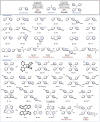Unified synthesis of multiply arylated alkanes by catalytic deoxygenative transformation of diarylketones
- PMID: 36320688
- PMCID: PMC9491083
- DOI: 10.1039/d2sc03720c
Unified synthesis of multiply arylated alkanes by catalytic deoxygenative transformation of diarylketones
Abstract
A deoxygenative transformation of diarylketones leading to multiply arylated alkanes was developed. Diarylketones were reacted with diphenylphosphine oxide resulting in a phospha-Brook rearrangement, followed by palladium-catalyzed cross-couplings or a Friedel-Crafts type alkylation to afford the corresponding multiply arylated alkanes. A variety of diarylketones can be converted to multiply arylated alkanes such as diarylmethanes, tetraarylethanes, and triarylmethanes by reduction, dimerization, and arylation in one pot. Furthermore, a one-pot conversion from arylcarboxylic acids to diarylmethanes and tetraarylethanes, and a synthesis of tetraarylmethane and triphenylethane using sequential coupling reactions are also presented.
This journal is © The Royal Society of Chemistry.
Conflict of interest statement
There are no conflicts to declare.
Figures





Similar articles
-
Deoxygenative Hetero- and Carbofunctionalizations of Diarylketones.J Org Chem. 2024 Jun 7;89(11):8157-8167. doi: 10.1021/acs.joc.4c00831. Epub 2024 May 10. J Org Chem. 2024. PMID: 38727022
-
Synthesis of α-Aryl Oxindoles by Friedel-Crafts Alkylation of Arenes.J Org Chem. 2020 May 1;85(9):6172-6180. doi: 10.1021/acs.joc.0c00370. Epub 2020 Apr 20. J Org Chem. 2020. PMID: 32259447
-
One-Pot Halogen Dance/Negishi Coupling of Dibromothiophenes for Regiocontrolled Synthesis of Multiply Arylated Thiophenes.Chemistry. 2016 Nov 7;22(46):16450-16454. doi: 10.1002/chem.201604293. Epub 2016 Oct 10. Chemistry. 2016. PMID: 27629814
-
Generation of C(sp3)-CAr bonds in the synthesis of triarylmethanes (TRAMs): comprehensive progress since 2009.Org Biomol Chem. 2025 Apr 9;23(15):3492-3519. doi: 10.1039/d4ob02069c. Org Biomol Chem. 2025. PMID: 40084579 Review.
-
Transition Metal-Catalyzed Cross-Couplings of Benzylic Sulfone Derivatives.Chem Rec. 2021 Dec;21(12):3978-3989. doi: 10.1002/tcr.202100210. Epub 2021 Sep 15. Chem Rec. 2021. PMID: 34523788 Review.
Cited by
-
Catalytic Reductive Homocoupling of Benzyl Chlorides Enabled by Zirconocene and Photoredox Catalysis.Precis Chem. 2024 Nov 7;3(1):43-50. doi: 10.1021/prechem.4c00077. eCollection 2025 Jan 27. Precis Chem. 2024. PMID: 39886378 Free PMC article.
-
Programmable Strategies for the Conversion of Aldehydes to Unsymmetrical (Deuterated) Diarylmethanes and Diarylketones.Org Lett. 2025 Apr 11;27(14):3637-3642. doi: 10.1021/acs.orglett.5c00748. Epub 2025 Mar 28. Org Lett. 2025. PMID: 40155201 Free PMC article.
-
Straightforward Superbase-Mediated Reductive O-Phosphorylation of Aromatic and Heteroaromatic Ketones with Red Phosphorus in the Superbase Suspension KOH/DMSO(H2O).Molecules. 2025 Mar 18;30(6):1367. doi: 10.3390/molecules30061367. Molecules. 2025. PMID: 40142143 Free PMC article.
-
Trivalent Phospha-Brook rearrangement enabled practical deoxygenative phosphonylation of carbonyls.Nat Commun. 2025 Apr 16;16(1):3628. doi: 10.1038/s41467-025-58990-1. Nat Commun. 2025. PMID: 40240401 Free PMC article.
-
Divergent Transformations of Aromatic Esters: Decarbonylative Coupling, Ester Dance, Aryl Exchange, and Deoxygenative Coupling.Acc Chem Res. 2024 Jun 18;57(12):1747-1760. doi: 10.1021/acs.accounts.4c00233. Epub 2024 May 31. Acc Chem Res. 2024. PMID: 38819671 Free PMC article.
References
-
- Alexander R. P. Warrellow G. J. Eaton M. A. W. Boyd E. C. Head J. C. Porter J. R. Brown J. A. Reuberson J. T. Hutchinson B. Turner P. Boyce B. Barnes D. Mason B. Cannell A. Taylor R. J. Zomaya A. Millican A. Leonard J. Morphy R. Wales M. Perry M. Allen R. A. Gozzard N. Hughes B. Higgs G. Bioorg. Med. Chem. Lett. 2002;12:1451–1456. doi: 10.1016/S0960-894X(02)00202-0. - DOI - PubMed
LinkOut - more resources
Full Text Sources
Other Literature Sources

